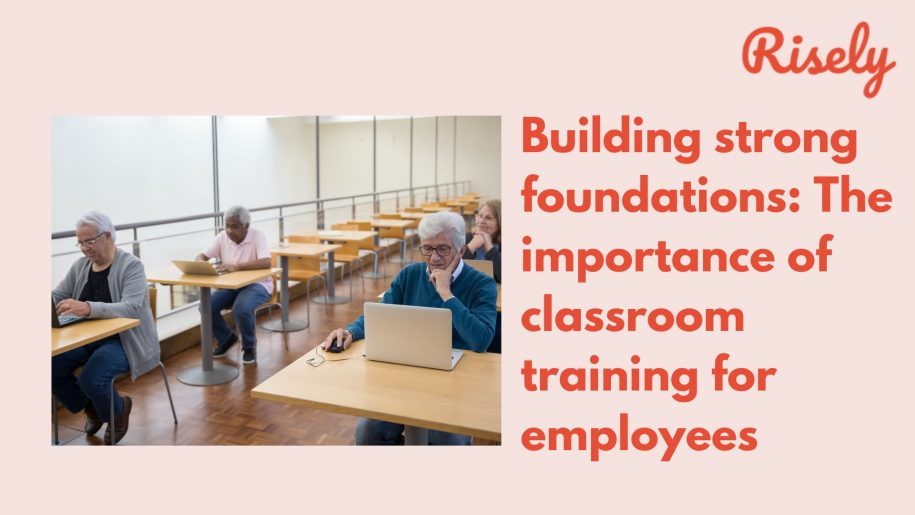Building Strong Foundations: The Importance of Classroom Training for Employees
Managers strive to equip employees with the knowledge and skills necessary to thrive in the current work environment. While technology has opened up various avenues for learning, the impact of classroom training remains unparalleled. Imagine a dynamic space where employees gather, exchange ideas and engage in interactive sessions that fuel their professional growth. Classroom training for employees is a transformative learning experience beyond the confines of a computer screen. This blog will discuss classroom training and explore its unique benefits, challenges, goals, and potential for unlocking employees’ potential. Whether you’re an HR manager seeking to revitalize your training initiatives or a team leader eager to embark on a learning journey, get ready to discover the power of face-to-face learning in an engaging and immersive setting.What is Classroom Training for Employees?
Classroom training for employees refers to a traditional form of training where employees gather in a physical classroom setting to receive instruction, guidance, and hands-on learning experiences. It involves a structured approach to learning led by an instructor or a teacher who facilitates the training sessions. Classroom training typically includes presentations, discussions, group activities, role-playing, and assessments to enhance knowledge acquisition and skill development. It allows employees to interact with the instructor and fellow participants, ask questions, and receive immediate feedback. Classroom training for employees can cover various topics, from technical skills to leadership development, and aims to improve employee performance, knowledge, and competencies in a focused and immersive environment.Goals of classroom training for employees
The goals of classroom training for employees include:- Knowledge acquisition: Classroom training aims to provide employees with the necessary knowledge and information related to their roles, tasks, or specific subjects. The goal is to ensure that employees have a solid understanding of the concepts, theories, and principles that underpin their work.
- Skill development: Classroom training focuses on developing employees’ skills and competencies relevant to their job roles. Whether technical skills, soft skills, or leadership abilities, the goal is to equip employees with the practical skills needed to perform their tasks effectively.
- Behavior change: Classroom training aims to influence employees’ behavior positively. It may involve training on topics such as communication, teamwork, diversity, or ethical practices to promote desirable behaviors and attitudes within the workplace.
- Performance improvement: Classroom training seeks to enhance employees’ performance by addressing specific areas of improvement or development. The goal is to provide employees with the tools, techniques, and knowledge necessary to improve their performance and achieve higher levels of productivity and efficiency.
- Compliance and policy adherence: Classroom training ensures employees know and adhere to policies, procedures, and legal requirements. The goal is to create a culture of compliance and reduce the risk of non-compliance, thereby protecting the team and its employees.
- Professional development: Classroom training supports employees’ professional growth and career advancement. The goal is to provide opportunities for employees to acquire new skills, expand their knowledge, and stay updated with industry trends, ultimately fostering their long-term career development.
Other Interesting Reads
Benefits of Classroom Training for Employees
Classroom training for employees offers several benefits that contribute to their professional growth and success. Some of the key benefits include:- Face-to-face interaction: Classroom training for employees provides direct interaction between trainers and employees. This allows for immediate clarification of concepts, personalized guidance, and the opportunity to ask questions, fostering a deeper understanding of the material.
- Engaging learning environment: Classroom training creates an engaging and dynamic learning environment. Interactive teaching methods, group discussions, role-playing, and real-time feedback keep employees actively involved in the learning process, leading to better knowledge retention.
- Networking and collaboration: Classroom training brings employees together, facilitating networking and collaboration among individuals from different departments or teams. This promotes cross-functional knowledge sharing, exchanging ideas, and the development of professional relationships, fostering a collaborative work culture.
- Immediate application of knowledge: Classroom training allows employees to practice and apply their newly acquired knowledge and skills through hands-on activities and case studies. This bridges the gap between theory and practice, enabling employees to transfer their learning directly to their job roles.
- Real-time feedback and assessment: Classroom training enables trainers to provide immediate and real-time feedback to assess employees’ progress. This helps identify areas of improvement and allows for timely intervention and support, enhancing employee learning outcomes and performance.
- Learning from experts: Classroom training often involves experienced trainers or subject matter experts who bring in-depth knowledge and practical insights to the learning process. Employees benefit from their expertise, industry experiences, and real-life examples, gaining valuable perspectives and enhancing their professional development.
- Long-term skill development: Classroom training is a foundation for long-term skill development. It equips employees with fundamental knowledge and competencies that form the basis for continuous learning and professional growth throughout their careers.

Disadvantages of Classroom Training for Employees
While classroom training for employees offers numerous benefits, there are also some disadvantages. These include:- Time and cost: Classroom training often requires employees to dedicate a specific amount of time away from their regular work responsibilities. This can result in productivity loss and increased travel, accommodation, and training materials costs.
- Limited flexibility: Classroom training follows a predetermined schedule and structure, which may not accommodate all employees’ individual learning needs and preferences. Some employees may prefer self-paced or on-the-job training methods that offer more flexibility.
- One-size-fits-all approach: Classroom training typically follows a standardized curriculum and teaching approach. While this ensures consistency, it may not cater to every employee’s unique learning styles, skill levels, or job requirements. Certain individuals may feel overwhelmed or bored due to the pace or content.
- Limited real-world context: Classroom training often focuses on theoretical concepts and scenarios that may not fully reflect employees’ real-world challenges in their roles. This can create a gap between training and practical application, requiring additional on-the-job training or support.
- Lack of individualized attention: In a classroom setting, trainers must address the learning needs of a group of employees, making it challenging to provide personalized attention to each individual. Some employees may require additional guidance or support, which may not be feasible in a classroom environment.
- Knowledge retention and transfer: Retaining and transferring knowledge learned in a classroom setting to actual job tasks can be a challenge. Without reinforcement and ongoing practice, employees may struggle to effectively apply the newly acquired skills and knowledge.
- Training bias: Classroom training can unintentionally perpetuate biases or favor certain learning styles over others. Employees with different backgrounds, learning preferences, or disabilities may not receive an equitable learning experience.
How can Managers Improve Classroom Training for Employees?
To improve classroom training for employees and enhance their learning experience, consider the following strategies:- Incorporate interactive activities: Include interactive activities such as group discussions, case studies, role-plays, and hands-on exercises. This encourages active participation, stimulates critical thinking, and reinforces learning.
- Use visual aids: Utilize multimedia elements like videos, graphics, and interactive presentations to make the training more engaging and visually appealing. Visual aids can enhance comprehension and retention of information.
- Create a supportive learning environment: Foster a supportive and inclusive learning environment where employees feel comfortable asking questions, sharing ideas, and collaborating with their peers. Encourage open communication and respect diverse perspectives.
- Provide real-world examples: Relate the training content to real-world scenarios and provide practical examples to help employees understand the practical application of the concepts. This makes the training more relevant and helps employees connect theory with practice.
- Personalize the training: Tailor the training to meet the employees’ specific needs and skill levels. Consider their roles, experience levels, and learning preferences when designing the content and delivery methods.
- Offer continuous feedback: Provide timely and constructive feedback to employees during the training. This helps them understand their progress, identify areas for improvement, and reinforce positive learning behaviors.
- Encourage peer learning: Promote peer-to-peer learning by incorporating group activities, collaborative projects, and discussions. This allows employees to learn from each other’s experiences, share knowledge, and build a supportive learning community.
- Embrace technology: Leverage technology tools and platforms to enhance the classroom training experience. This can include online resources, e-learning modules, interactive quizzes, and virtual simulations to supplement and reinforce in-person training.
Conclusion
In conclusion, classroom training for employees remains a powerful and effective approach to learning and development in today’s digital age. While technology has opened up new avenues for training, the value of face-to-face interactions and immersive learning experiences must be considered. Classroom training offers a unique blend of engagement, collaboration, and personalized attention that fosters growth and development. Through classroom training, employees can engage in interactive discussions, participate in hands-on activities, and receive immediate feedback from trainers and peers. The dynamic nature of the classroom environment facilitates knowledge retention, skills enhancement, and the building of valuable relationships within the organization. Classroom training offers a refreshing and human-centered approach to employee development in a world where technology dominates many aspects of our lives. It brings people together, promotes collaboration, and creates an atmosphere conducive to growth and innovation. So, let us embrace the power of classroom training and unlock our employees’ full potential. Together, we can create a learning environment that nurtures talent, fuels growth, and paves the way for a brighter future.Build effective classroom training programs with solid constructive feedback skills.
Take the free constructive feedback skill assessment now to enable success for your team.
Frequently asked questions
What is the classroom training method?
Classroom training is a traditional form where employees gather in a physical classroom setting to learn from an instructor. It involves lectures, discussions, demonstrations, and interactive activities to deliver knowledge and skills to employees.
What kind of training can be given to employees?
Various types of training can be given to employees, including on-the-job training, skills training, leadership training, customer service training, compliance training, technology training, and professional development training. The type of training depends on the organization’s and its employees’ specific needs and goals.
How do you give training to employees?
Training can be delivered through different methods, such as classroom-based training, online courses, workshops, seminars, mentoring programs, on-the-job training, and self-paced learning modules. The choice of training method depends on factors such as the nature of the training, availability of resources, and the preferences of employees.
What are the 3 types of training?
The three common types of training are:
– On-the-Job Training
– Classroom Training
– Online Training
– On-the-Job Training
– Classroom Training
– Online Training
Other Related Blogs
How to Create a Course with AI: A Guide for L&D Professionals
How to Create a Course with AI: A Guide for L&D Professionals According to a McKinsey survey(1), only 11% of business leaders believe their leadership development initiatives yield meaningful results.…
How to build a Learning and Development Action Plan ft Katie Greenwood
How to build a Learning and Development Action Plan ft Katie Greenwood Does your company’s Learning and Development (L&D) strategy feel like more “guessing” than “winning”? You’re not the only…
Generative AI for Learning and Development: Getting Started
Generative AI for Learning and Development: Getting Started In 2024, organizations spent $401 billion globally on corporate training(1), yet 70% of employees report feeling unprepared for the future of work…
Future proofing a learning strategy for organizations with Inna Horvath
Future Proofing a Learning Strategy for Organizations with Inna Horvath With the advent of AI, everyone’s anticipating changes. L&D leaders in charge of building a learning strategy for organizations are…


